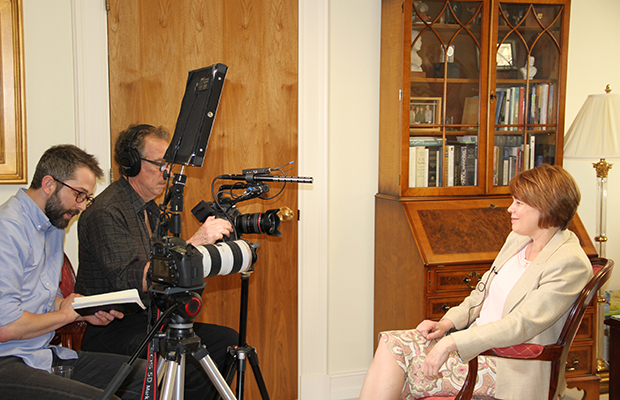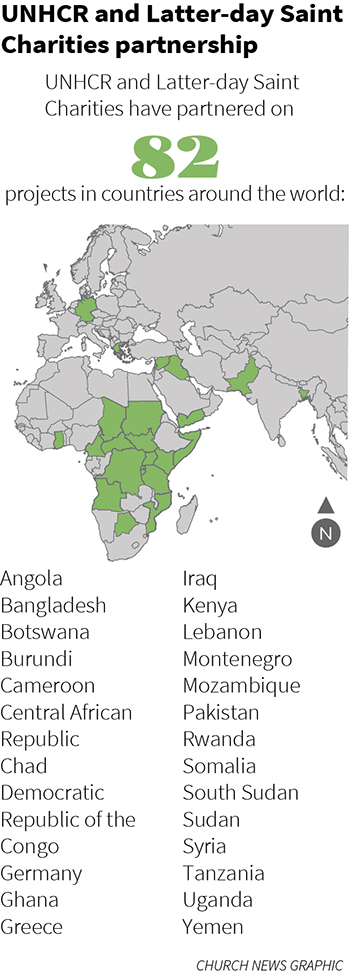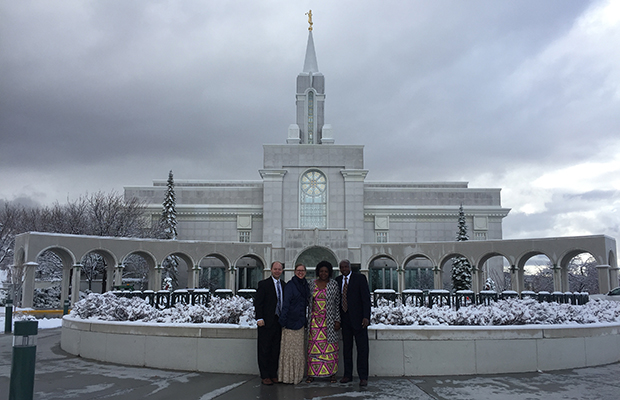“Reach Out and Help” Resettled Refugees, Says Relief Society General President
Contributed By Aubrey Eyre, Church News staff writer

Sister Jean B. Bingham and her friends Asifa Nadir, left, and Nadira Nadir sit outside the Relief Society Building on Temple Square prior to an interview with representatives from USA for UNHCR on May 16, 2019. Sister Bingham has known the Nadir family, refugees from Afghanistan, for nearly 15 years.
Article Highlights
- Latter-day Saint Charities is helping refugees make their transition to the U.S. smoother.
- Latter-day Saints should reach out and help resettled refugees in their communities.
“The more you’re with people, the more you know them individually, and you learn to love them.” —Sister Jean B. Bingham, Relief Society General President
Related Links
Despite the bright studio light shining on her face and the three people moving around her to adjust the camera equipment and small microphone attached to her jacket, Sister Jean B. Bingham focused on the two women sitting near the door across the room from her.
Sitting quietly, curiously observing as several people fussed over the woman they refer to simply as “Teacher,” the two women smiled each time Sister Bingham reassuringly looked in their direction.
For nearly 15 years, Sister Bingham, Relief Society General President for The Church of Jesus Christ of Latter-day Saints, has served as a teacher and friend to Asifa and Nadira Nadir.
As refugees from Afghanistan, the Nadirs—Asifa and her daughter, Nadira—first met Sister Bingham while she was volunteering at the English Skills Learning Center in Salt Lake City. As a volunteer, Sister Bingham took on the role of helping the Nadir family learn enough English to pass their citizenship tests. And although she no longer works as an official volunteer, even now, years later, she has remained their close friend and mentor.
“It’s been a wonderful experience to learn from them and to learn with them,” Sister Bingham said of their continuing friendship. “The more you’re with people, the more you know them individually, and you learn to love them.”
Like many refugees who have been resettled in the United States, the Nadirs knew very little English when they arrived here and even less about the culture and customs typical of an American society.
As Sister Sharon Eubank, First Counselor in the Relief Society General Presidency and president of Latter-day Saint Charities, often says, refugees and immigrants need three things to make them feel welcome in a community: “They need a friend, they need meaningful work, and they need to be able to practice their peaceful faith.”
For the Nadirs, much of their sense of belonging came from the friend they found in Sister Bingham and the opportunities made available to them through organizations working to build a more welcoming community.
This year, after more than a decade of friendship, the Nadirs joined Sister Bingham on Temple Square on May 16 as she participated in making a video with the United Nations High Commissioner for Refugees (UNHCR) to honor and raise awareness for World Refugee Awareness Month, annually recognized in June, and World Refugee Day on June 20.
Sitting in front of the UNHCR camera crew in her office in the Relief Society Building, Sister Bingham shared some of the details of her relationship with the Nadirs and what it has meant to her over the years. She also gave some advice.
“If I were to give a message to the [Latter-day Saint] community about resettled refugees,” she said, “I would say reach out and help.”

Sister Jean B. Bingham sits in her office in the Relief Society Building on Temple Square for an interview with Nicholas Feeney, right, and Lucian Perkins from USA for UNHCR on May 16, 2019. Photo by Aubrey Eyre.
A Long-Standing Partnership
The Office of the UNHCR is a United Nations program established in 1950 with the mandate to protect refugees, forcibly displaced communities, and stateless people. It works to help them to return home, to integrate into a new community, or to be legally resettled in a third country.
Since 1991, the Church-owned organization Latter-day Saint Charities has partnered with UNHCR to bring relief and comfort to refugees—both in emergency settings and in resettlement countries. As a means of showcasing that partnership and the work that both organizations are doing to help raise awareness for refugees around the world, Nicholas Feeney, a communications officer from USA for UNHCR, teamed up with renowned filmmaker Lucian Perkins to highlight that partnership in a video project for World Refugee Day.
In their interviews with both Sister Bingham and Sister Eubank, the UNHCR crew spotlighted how the combined efforts of UNHCR and Latter-day Saint Charities have made an impact on the Latter-day Saint and refugee communities.
Sister Eubank explained that UNHCR can broker aid responses when multiple countries are involved and that they coordinate the assistance coming in from aid organizations to reduce duplication and ensure it reaches the people who need it most. They advocate for the human rights of those who have been affected by conflict, persecution, and disaster—the majority of whom are women and children.
“No other country or organization is able to play that role,” she said. “Our partnership is a recognition of how important it is to be part of a coordinated, holistic effort that magnifies the efforts of governments, humanitarian organizations, and the leaders of the refugee communities themselves.”
She added that the partnership is also important to Latter-day Saint Charities because registration as a United Nations–accredited partner opens additional opportunities for the Church.
“The Church of Jesus Christ of Latter-day Saints is a global faith with congregations in more than 160 countries. Invitations for us to speak with other leaders about how faith, human rights, humanitarian work, and government efforts intersect are important opportunities to build bridges of understanding,” she said.

Sister Sharon Eubank sits in her office in the Relief Society Building on Temple Square for an interview with Nicholas Feeney, left, and Lucian Perkins from USA for UNHCR on May 16, 2019. Photo by Aubrey Eyre, Deseret News.
Speaking for the UNHCR side of things, Anne-Marie Grey, executive director and CEO of USA for UNHCR, noted that their relationship with Latter-day Saint Charities “continues to grow in terms of both programmatic scope and financial investment.” She added, “This is a very exciting partnership delivering real impact in the lives of refugees.”
And with three to five major refugee crises going on all at the same time in the last five years, Sister Eubank explained that their shared roles and interests are increasingly important.
“People want to do something. They want to help, and they want to respond,” she told the UNHCR film crew. And people have responded in an amazing variety of ways, she said.
Using Sister Bingham’s work with the Nadir family as an example of the impact volunteering can have, Sister Eubank said: “Her relationship with Asifa and Nadira Nadir has enriched her life so much. And even though she’s a very busy person that travels all the time, she would never give that up. It’s one of the most important things for her, and that opportunity is available to anybody who cares to get involved.”

Sister Jean B. Bingham sits outside on Temple Square with Asifa Nadir while being filmed by Lucian Perkins from USA for UNHCR on May 16, 2019. Sister Bingham has known the Nadir family, refugees from Afghanistan, for nearly 15 years. Photo by Aubrey Eyre, Deseret News.
Members of the Church have the knowledge that each person on earth is a son or daughter of Heavenly Father, Sister Bingham explained, “and that makes them our brothers and sisters.”
With each individual and family having a variety of needs, “no matter what our individual skills and abilities are, there is some way each person can contribute to the happiness of someone else,” she said.
The ways people can help refugees are as varied as the people themselves, Sister Eubank told the UNHCR crew.
”We don’t see refugees as a drain on our community,” she said. “We see them as bringing richness and talent. When we become friends, we get to share that variety of richness—the innovation, the experiences, the languages, the examples they bring. We’ve really seen strength come into our communities through these relationships and friendships.”

Children from the Bakunz and Graham families pose for a photo during a visit and interview with representatives from USA for UNHCR on May 18, 2019. Photo by Lucian Perkins.
Reaching Out and Welcoming
For the Graham family of Provo, Utah, who were also featured in the UNHCR video, the desire to reach out and help refugees came after hearing a talk by Elder Patrick Kearon, a General Authority Seventy, given in general conference in April 2016.
Sister Eubank referred to Elder Kearon’s message as a “clarion call for people to act,” and for Dawn and Charles Graham, it served as the push they needed to begin finding ways to help resettled refugees in their area.
After connecting with the Utah Community & Refugee Partnership Center (UCRPC) in Utah County, the Grahams became a family alliance partner. In that capacity, the Grahams essentially sponsor new refugee families and help them in a variety of ways—from getting settled in their area and helping cover a portion of their rent during their first few months to helping them learn how to light the pilot light on their furnace in the winter.
“These are people who have experienced horrible things in their lives and have escaped from that, and now they are kind of plunked down in a society that they don’t understand, that’s not their same culture,” Dawn Graham said. “So we want to reach out to them and show love and kindness and support in a way that we would want if we were in their situation.”
Both Sister Bingham and Graham noted that as descendants of early Church pioneers, their own ancestors shared many of the experiences of refugees today.
“Our pioneer ancestors were thrown out of their communities,” Graham said. So, as members of the Church, it is important to be willing to reach out and love those going through similar experiences today.
For Sister Bingham, reading the journal entries of her pioneer ancestors has allowed her to feel their sorrows. And those same experiences, of being displaced through no fault of their own, are the same things refugees are going through now, she said. “They feel that same anxiety of wondering what’s going to happen to [their] family.”
She added that when confronted with these anxieties, each person wants to feel loved, cared for, and secure.
“So when we can work one on one with someone or with a family, we can have a significant impact,” she said.
In their time volunteering with UCRPC so far, the Grahams have been able to sponsor three refugee families. One of the families with whom they have worked has become a bit like extended family and has changed their lives in wonderful ways.
Donatira Kabaji and Mitonzi Bakunz fled their home in the Congo because of war. With nine children, they left everything they knew behind to seek safety for their family. After one child died of malaria while they were living in a refugee camp, the remaining 10 family members, with the help of the UNHCR, were resettled together in Utah.
The Grahams acted as the Bakunzes’ family alliance partner for six months after they arrived, but since then, similar to Sister Bingham and the Nadirs, they have continued to remain close.

From left, Dawn Graham, Donatira Kabaji, Mitonzi Bakunz, and Charles Graham sit together in the Graham home during a visit and interview with representatives from USA for UNHCR on May 18, 2019. Photo by Lucian Perkins.
“For me, working with the Bakunzi family has been a blessing,” Charles Graham told the Church News. “We have become good friends. Doing things with them has helped me to gain a different perspective on life and to see how challenging it is for refugee families to learn to survive in a new culture with a new language.”

UNHCR and Latter-day Saint Charities have partnered on 82 projects in 25 countries. Graphic by Joseph Tolman, Deseret News.
For many refugees, particularly those who don’t find a support network through refugee resettlement organizations or friendly neighbors, learning to navigate everyday aspects of life in the U.S. such as transportation and school systems, insurance, and even purchasing or renting homes can be extremely challenging, he explained.
Added Dawn Graham: “So just being willing to reach out, help, and love them can make a big difference. And once you get to know a family, you realize that everyone has their own story, and a lot of times, they’re an example to us.”
After spending a Saturday in May with the Bakunz family as the UNHCR film crew captured their interactions, Dawn Graham said she thinks it is important for people to see both ends of refugee stories.
“I liked the idea that [the UNHCR was] coming here and would be able to show what happens to refugees when they’re able to integrate into a community,” she told the Church News. “So they’re not just showing the plight of the refugees in the camps—although that is important too.”
It can be hard to believe so many refugees have had to flee their homes and live in camps—sometimes waiting for years to be resettled—and that they’ve made it through all of that, Dawn Graham said.
“But it’s also important to see that when refugees are allowed to come and be resettled, that they can have a lot of success and that their stories can be really different from those stories in the camps.”
Sharing why the UNHCR decided to feature Latter-day Saint Charities and the Graham family in the World Refugee Day video project, Grey said, “It shows how members of The Church of Jesus Christ of Latter-day Saints are making a difference in the lives of newly resettled refugees in their local communities. Collaborating with Latter-day Saint Charities on this story deepens our relationship and expands the scope of support both organizations are bringing to refugees.”

Sister Jean B. Bingham sits outside on Temple Square with Asifa Nadir, left, and Nadira Nadir, right, while being filmed by Lucian Perkins from USA for UNHCR on May 16, 2019. Sister Bingham has known the Nadir family, refugees from Afghanistan, for nearly 15 years. Photo by Aubrey Eyre, Deseret News.

Dawn Graham plays with children from the Bakunz family as they gather at the UCRPC facility in Utah County while being filmed by representatives from USA for UNHCR on May 18, 2019. Photo by Lucian Perkins.

Mitonzi Bakunz, Donatira Kabaji, and one of their children greet Charles Graham at the UCRPC facility in Utah County during a visit and interview with representatives from USA for UNHCR on May 18, 2019. Photo by Lucian Perkins.

Sister Jean B. Bingham walks with Asifa Nadir, left, and Nadira Nadir, right, on Temple Square while being filmed by Lucian Perkins from USA for UNHCR on May 16, 2019. Sister Bingham has known the Nadir family, refugees from Afghanistan, for nearly 15 years. Photo by Aubrey Eyre, Deseret News.

From left, Charles Graham and Dawn Graham stand with Donatira Kabaji and Mitonzi Bakunz in front of the Bountiful Utah Temple after accompanying them through the temple for their first time. Photo courtesy of Dawn Graham.

Donatira Kabaji and Mitonzi Bakunz stand in front of the Bountiful Utah Temple after receiving their endowments. Photo courtesy of Dawn Graham.

From left, Charles Graham stands with Mitonzi Bakunz and Donatira Kabaji and two of their children. Photo courtesy of Dawn Graham.

The Graham family and the Bakunz family gather for a shared meal at the Grahams’ house. Photo courtesy of Dawn Graham.

Dawn Graham plays with children from the Bakunz family as they gather at the UCRPC facility in Utah County while being filmed by representatives from USA for UNHCR on May 18, 2019. Photo by Lucian Perkins.
